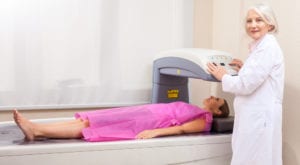Written by Joyce Smith, BS. Compared to supplementation with RCE alone, a twice daily RCE intake over a 12-month period significantly attenuated BMD loss caused by estrogen deficiency, improved bone turnover, promoted a favorable estrogen metabolite profile (2-OH:16a-OH), and stimulated equol production in postmenopausal women with osteopenia.
 During menopause, endogenous estrogen levels naturally decline which reduces bone mineral density (BMD) and negatively impacts bone structure, increasing the risk of osteoporosis and bone fractures 1. The National Osteoporosis Foundation recommends 1200 mg calcium and 20-25 ug vitamin D (CaD) daily for osteopenia. Studies have shown that CaD protocol reduced total-and hip-fracture risk by 15% and 30% in patients 65 years and older 2. Other studies have supported the use of estrogen for prophylaxis and treatment of estrogen-deficient osteoporosis 3,4. Isoflavones occur naturally in legumes, such as soy and red clover 5. While estrogen is an agonist with an affinity for binding with both estrogen receptor alpha (ERα) present in cancer- sensitive tissues and estrogen receptor beta (ERß), isoflavones have an affinity only for ERß which is present in bone tissue and bone marrow; thus isoflavones can function as estrogens to support healthy bone without affecting cancer sensitive tissues in the body 6.
During menopause, endogenous estrogen levels naturally decline which reduces bone mineral density (BMD) and negatively impacts bone structure, increasing the risk of osteoporosis and bone fractures 1. The National Osteoporosis Foundation recommends 1200 mg calcium and 20-25 ug vitamin D (CaD) daily for osteopenia. Studies have shown that CaD protocol reduced total-and hip-fracture risk by 15% and 30% in patients 65 years and older 2. Other studies have supported the use of estrogen for prophylaxis and treatment of estrogen-deficient osteoporosis 3,4. Isoflavones occur naturally in legumes, such as soy and red clover 5. While estrogen is an agonist with an affinity for binding with both estrogen receptor alpha (ERα) present in cancer- sensitive tissues and estrogen receptor beta (ERß), isoflavones have an affinity only for ERß which is present in bone tissue and bone marrow; thus isoflavones can function as estrogens to support healthy bone without affecting cancer sensitive tissues in the body 6.
In a 12-month, randomized, double-blind, parallel design, placebo-controlled trial 7, 78 postmenopausal osteopenic women (osteopenia defined as a bone mineral density T-score between −1.0 and −2.5) supplemented daily with 1200 mg calcium, 550mg magnesium, and 25 ug calcitriol (CMD). In addition, they received either red clover extract (RCE) equivalent to 60 mg of isoflavones per day and a probiotic or a placebo extract. The probiotic would hopefully provide a favorable intestinal bacterial profile that would improve bioavailability and together with the RCE, would improve the BMD in the osteopenic postmenopausal participants.
Compared to the control group results were as follows:
- Dual-energy X-ray absorptiometry (DXA) scan showed significantly less bone loss in L2-L4 of the lumber spine (P < 0.05), and the femoral neck (P < 0.01) and trochanter (P < 0.01) areas.
- Computed tomography (CT) scan revealed a significant decrease in bone resorption biomarkers (P=0.045).
- Isoflavone concentration was significantly elevated in RCE group from 0-12 months and equol significantly increased (p<0.0001) at 6 months.
- The urinary estrogen metabolite ratio [2-hydroxyestrone (2-OH) to 16a-hydroxyestrone (16a-OH)] ratio was also significantly increased in the RCE group (P<0.05).
The authors recommend a longer study duration to lend more credibility to the results. Also, the use of CT scans rather than DXA scans would provide a better picture of isoflavone effects on cortical compared to trabecular bone 8 and the use of bone turnover biomarkers such as sclerostin and alkaline phosphatase would provide a better picture of bone turnover. Self-reported food diaries and the use of only postmenopausal participants who were not overweight, obese, or hypertensive were additional limitations.
Source: Lambert, Max Norman Tandrup, Catrine Bundgaard Thybo, Simon Lykkeboe, Lars Melholt Rasmussen, Xavier Frette, Lars Porskjær Christensen, and Per Bendix Jeppesen. “Combined bioavailable isoflavones and probiotics improve bone status and estrogen metabolism in postmenopausal osteopenic women: a randomized controlled trial.” The American journal of clinical nutrition 106, no. 3 (2017): 909-920.
© 2017 American Society for Nutrition
Click here to read the full text study.
Posted September 30, 2019.
Joyce Smith, BS, is a degreed laboratory technologist. She received her bachelor of arts with a major in Chemistry and a minor in Biology from the University of Saskatchewan and her internship through the University of Saskatchewan College of Medicine and the Royal University Hospital in Saskatoon, Saskatchewan. She currently resides in Bloomingdale, IL.
References:
- Papaioannou A, Morin S, Cheung A, et al. Clinical practice guidelines for the diagnosis and management of osteoporosis in Canada: Background and technical report. Scientific Advisory Council of Osteoporosis Canada, Ontario. 2010.
- Weaver C, Alexander D, Boushey C, et al. Calcium plus vitamin D supplementation and risk of fractures: an updated meta-analysis from the National Osteoporosis Foundation. Osteoporosis International. 2016;27(1):367-376.
- Cauley JA, Robbins J, Chen Z, et al. Effects of estrogen plus progestin on risk of fracture and bone mineral density: the Women’s Health Initiative randomized trial. Jama. 2003;290(13):1729-1738.
- Michael YL, Gold R, Manson JE, et al. Hormone therapy and physical function change among older women in the Women’s Health Initiative: a randomized controlled trial. Menopause (New York, NY). 2010;17(2):295.
- Jung W, Yu O, Lau S-MC, et al. Identification and expression of isoflavone synthase, the key enzyme for biosynthesis of isoflavones in legumes. Nature biotechnology. 2000;18(2):208.
- Heldring N, Pike A, Andersson S, et al. Estrogen receptors: how do they signal and what are their targets. Physiological reviews. 2007;87(3):905-931.
- Lambert MNT, Thybo CB, Lykkeboe S, et al. Combined bioavailable isoflavones and probiotics improve bone status and estrogen metabolism in postmenopausal osteopenic women: a randomized controlled trial. The American journal of clinical nutrition. 2017;106(3):909-920.
- Farr JN, Khosla S, Miyabara Y, Miller VM, Kearns AE. Effects of estrogen with micronized progesterone on cortical and trabecular bone mass and microstructure in recently postmenopausal women. The Journal of Clinical Endocrinology & Metabolism. 2013;98(2):E249-E257.
